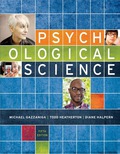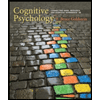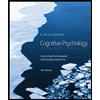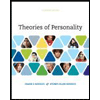
a.
Introduction:
Human beings are social creatures. In order to survive, they need to depend on fellow beings. They realized the benefits of cooperation and social interaction when they started to live in groups. Groups give a kind of social identity to every individual. People define themselves in terms of social groups and easily differentiate others who don’t fit to those groups. Based on this, social psychology defines two types of groups- ingroup and outgroup. Ingroups are the social groups to which one belong and outgroups are those social groups to which one does not belong.
a.
Answer to Problem 1PT
Correct answer:
A first year college student states, “Students at our college are so unique! Each person has his or her own passions and aptitudes”.
This statement is an example of ingroup favoritism.
Explanation of Solution
Ingroup favoritism is the concept where the members of one’s ingroup are more favored and privileged than members of an outgroup. To the first year college student, all members or his or her college forms her ingroup. So, she favors them by praising their uniqueness and portrays them as efficient people with their own passions and aptitudes.
b.
Introduction:
Human beings are social creatures. In order to survive, they need to depend on fellow beings. They realized the benefits of cooperation and social interaction when they started to live in groups. Groups give a kind of social identity to every individual. People define themselves in terms of social groups and easily differentiate others who don’t fit to those groups. Based on this, social psychology defines two types of groups- ingroup and outgroup. Ingroups are the social groups to which one belong and outgroups are those social groups to which one does not belong.
b.
Answer to Problem 1PT
Correct answer:
A professor mistakenly comments to a colleague, “The athletes in my class always seem to ask for extensions on their homework; none of my other students ever ask for extensions”.
This statement is an example of illusory correlation.
Explanation of Solution
Illusory correlation is the concept in psychology where one assumes that there is a relation between two variables that are not actually related. In this example, professor makes a wrong conclusion about the athletes of his class. The athletes asked for extensions on their homework which made him conclude that they always do that. He may have had the same experience with other students also. He might have forgot or other students might have escaped somehow.
c.
Introduction:
Human beings are social creatures. In order to survive, they need to depend on fellow beings. They realized the benefits of cooperation and social interaction when they started to live in groups. Groups give a kind of social identity to every individual. People define themselves in terms of social groups and easily differentiate others who don’t fit to those groups. Based on this, social psychology defines two types of groups- ingroup and outgroup. Ingroups are the social groups to which one belong and outgroups are those social groups to which one does not belong.
c.
Answer to Problem 1PT
Correct answer:
A senior at College A tells her friend, “Whatever you do, don’t go to parties at College B. They all drink way too much, and the guys can’t keep their hands off the women at their parties”.
This statement is an example of outgroup homogeneity.
Explanation of Solution
Outgroup homogeneity effect is the tendency to see members of the outgroup as less varied than members of the ingroup. To a student of College A, students of College B are an outgroup and they appear to be less varied than them. This is why the senior of College A tends to have a common opinion about the guys of College B.
Want to see more full solutions like this?
Chapter 12 Solutions
EBK PSYCHOLOGICAL SCIENCE (FIFTH EDITIO
- Can excessive use of social media has been linked to increased levels of anxiety, depression, and loneliness, particularly among younger users?arrow_forwardHow exposure to diverse cultures and ideas broadens one's perspective of the world, yet it can also result in cultural appropriation or homogeneity?arrow_forwardHow to develop a proposal outline with examples on How Social Media Influences Human Behavior.arrow_forward
- While reading this article can you explain strong point , weaknesses point an future study https://doi.org/10.1126/science.1182238arrow_forwardWhat are your thoughts of this article https://doi.org/10.1126/science.1182238arrow_forwardWhile readings this article what does this explain about the people https://doi.org/10.1126/science.1182238arrow_forward
- Make a graph based on this data below : based on group A and Group B Group A (Bilingual): Vocabulary Task Response Times (seconds): [1.1, 1.3, 1.2, 1.0, 1.4, 1.3, 1.2, 1.1, 1.0, 1.2] Sentence Construction Task Response Times (seconds): [2.0, 2.1, 1.9, 1.8, 2.2, 2.1, 1.7, 2.0, 1.8, 1.9] Group B (Monolingual): Vocabulary Task Response Times (seconds): [1.5, 1.6, 1.5, 1.4, 1.7, 1.5, 1.8, 1.6, 1.5, 1.6] Sentence Construction Task Response Times (seconds): [2.5, 2.6, 2.5, 2.7, 2.4, 2.6, 2.7, 2.5, 2.5, 2.6] 2. Outcome of the Experiment The outcome showed that bilingual individuals performed better, with faster response times in both vocabulary retrieval and sentence construction tasks compared to monolingual individuals. 3. Descriptive Statistics Group A (Bilingual): Vocabulary Task: Mean: Mean=10(1.1+1.3+1.2+1.0+1.4+1.3+1.2+1.1+1.0+1.2)=1.21s Standard Deviation (SD): SD≈0.11s Sentence Construction Task: Mean: Mean=10(2.0+2.1+1.9+1.8+2.2+2.1+1.7+2.0+1.8+1.9)=1.99s SD:…arrow_forwardIn this article, can you explain each of the three games ultimatum game, the dictator game, and the party punishment game? Also, how many days did they play the game, and did people know about it? https://doi.org/10.1126/science.1182238arrow_forwardIn this article can you describe the fairness an punishment for market, religion and community https://doi.org/10.1126/science.1182238arrow_forward
- In this article what was the advantage an disadvantage of this article and what was the point of the article. https://doi.org/10.1126/science.1182238arrow_forwardIn this article what was the method and what was the results https://doi.org/10.1126/science.1182238arrow_forwardCan you help me find 10 interested discussion topics on evolutionary psychology &culturearrow_forward
 Ciccarelli: Psychology_5 (5th Edition)PsychologyISBN:9780134477961Author:Saundra K. Ciccarelli, J. Noland WhitePublisher:PEARSON
Ciccarelli: Psychology_5 (5th Edition)PsychologyISBN:9780134477961Author:Saundra K. Ciccarelli, J. Noland WhitePublisher:PEARSON Cognitive PsychologyPsychologyISBN:9781337408271Author:Goldstein, E. Bruce.Publisher:Cengage Learning,
Cognitive PsychologyPsychologyISBN:9781337408271Author:Goldstein, E. Bruce.Publisher:Cengage Learning, Introduction to Psychology: Gateways to Mind and ...PsychologyISBN:9781337565691Author:Dennis Coon, John O. Mitterer, Tanya S. MartiniPublisher:Cengage Learning
Introduction to Psychology: Gateways to Mind and ...PsychologyISBN:9781337565691Author:Dennis Coon, John O. Mitterer, Tanya S. MartiniPublisher:Cengage Learning Psychology in Your Life (Second Edition)PsychologyISBN:9780393265156Author:Sarah Grison, Michael GazzanigaPublisher:W. W. Norton & Company
Psychology in Your Life (Second Edition)PsychologyISBN:9780393265156Author:Sarah Grison, Michael GazzanigaPublisher:W. W. Norton & Company Cognitive Psychology: Connecting Mind, Research a...PsychologyISBN:9781285763880Author:E. Bruce GoldsteinPublisher:Cengage Learning
Cognitive Psychology: Connecting Mind, Research a...PsychologyISBN:9781285763880Author:E. Bruce GoldsteinPublisher:Cengage Learning Theories of Personality (MindTap Course List)PsychologyISBN:9781305652958Author:Duane P. Schultz, Sydney Ellen SchultzPublisher:Cengage Learning
Theories of Personality (MindTap Course List)PsychologyISBN:9781305652958Author:Duane P. Schultz, Sydney Ellen SchultzPublisher:Cengage Learning





